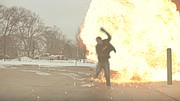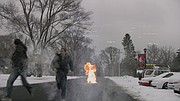A special effects movie wizard
Manuel Valdes | Hagadone News Network | UPDATED 15 years, 10 months AGO
SEATTLE - For years, film student Bill Parker had a nagging idea for a short movie: He'd show those letters from the "Star Wars" opening scroll raining down on Earth and exploding.
But the visual effects necessary to make his short film weren't available or affordable to him. Until now.
Using a couple of computer programs, including one that packages computerized explosions, the 20-year-old from Warrenville, Ill., produced his fan movie in December. The video went viral, getting 460,000 hits on YouTube.
"Today, in 2010, it is a lot easier and cheaper to do this stuff," Parker said. "When I finished it, I was really impressed with it... I was pretty surprised at how well it took off."
The video - called "Star Wars vs. Star Trek" - features more than a dozen realistic-looking explosions hitting the streets of Warrenville, and a 3-D, flying model of the USS Enterprise, "Star Trek's" chief spaceship, equipped with laser beams.
Parker's short movie is one of scores of online videos popping up with visual effects that just a generation ago would have been possible only for big Hollywood studios, with big budgets and armies of computer animators. Today the falling cost of computing power and cameras, along with the free distribution possible over the Internet, are giving everyday people more chances to follow their creative instincts.
Of course, big Hollywood productions, such as James Cameron's "Avatar," are advancing special-effects technology to expensive new heights. But even with a small budget, there are enough special effects available to people creating videos inspired by existing franchises or entirely new imagery for original shorts.
"It's amazing and refreshing what one can create without needing a huge studio," said Alex Billington, editor at the movie blog Firstshowing.net, which often posts these types of videos. Cheaper effects "will simply show that you don't need Hollywood to make a movie. That will cause more people to experiment with filmmaking."
Last year, a short movie produced by a young filmmaker in Uruguay featured giant robots attacking the country's capital, Montevideo. It depicted destroyed buildings, explosions and zooming fighter jets. Fede Alvarez told the BBC he made the short - "Ataque de Panico!" ("Panic Attack!") - for a mere $300.
Among the viewers was "Spider-Man" director Sam Raimi, who was impressed enough to offer Alvarez a chance to develop a project with his production company.
Eric Furie, a digital systems specialist who teaches a motion-capture class at the University of Southern California, said changing technology has fragmented the special effects industry, which once had only a few big companies. It's not unusual, he said, for Hollywood studios now to contract a handful of companies for projects.
In the 1990s, programmers and animators at George Lucas' Industrial Light and Magic had to write their own software code to produce the visual effects that made dinosaurs appear in "Jurassic Park." Now, off-the-shelf effects programs easily enable that. Because there's less coding, and less math, required to animate a visual effect, more regular people can try their hands at being a special effects wizard.
One popular software package, After Effects from Adobe Systems Inc., sells for about $1,000. Another program that packages explosions and other prefabricated effects costs about $100. Smaller effects "plug-ins" can be downloaded on the Internet for free. Three-D models, such as the Enterprise used by Parker, are also available for free on the Web.
Still, producing special effects can be time-consuming and tedious. It took Parker about four weeks to layer the explosions and animate the model of the Enterprise in his short.
In San Francisco, another budding filmmaker, Mike Horn, needed at least 800 hours of work for a three-minute "Star Wars"-inspired video.
"Each shot took at least a minimum of six hours for me to do," Horn said. "A lot of sleepless nights."
ARTICLES BY MANUEL VALDES

Slide rescuers battle rain, exhaustion
Six climbers believed dead in Mount Rainier fall






